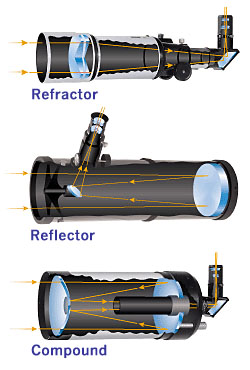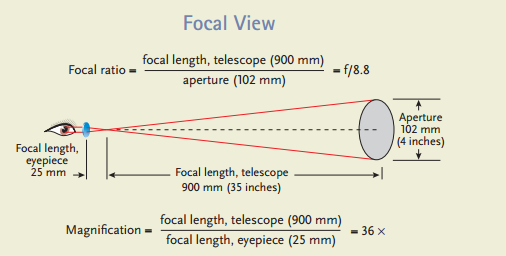Any telescope can literally open your eyes to a universe of celestial delights, but it is important to choose the right one for you – based on your primary observing interests, experience, and the budget of course. With the basic information, you will know what to look for and what to avoid when you’re buying your first telescope. A good telescope has high-quality optics and a steady working mount, which is essential.
Telescope features
Aperture
The most important characteristic of a telescope is its aperture often called the objective. The aperture is actually the diameter of its light-gathering lens or mirror. Keep in mind that your telescope should have at least 2.8 inches (70 mm) aperture and preferably more.The larger aperture – the less faint objects, cleaner image, and finer details. The small telescope can do a great job in the area far from the city lights. The dark locations give you the opportunity to gaze the distant galaxies even with the small scope.
Focal length
Every scope has a focal length, which is effectively the distance from the primary lens or mirror to the image it forms. Sky&telescope suggests avoiding telescopes that are advertised by their magnification, especially implausibly high powers like 600×. For most purposes, a telescope’s maximum useful magnification is 50 times its aperture in inches (or twice its aperture in millimeters).
Finder
When used at medium to high power, a telescope shows you only a tiny little bit of sky. looking through the telescope itself can be difficult at high magnifications. A finder assists you in locating celestial objects. The telescope finder makes it easier for you to find objects in the sky.
Types of telescopes
There are three basic types of telescopes. All of them use the different optics to achieve the same result.
- Refractors have a lens at the front of the tube.
 They quickly get expensive as the aperture increases, but they are quite easy to maintain.
They quickly get expensive as the aperture increases, but they are quite easy to maintain. - Reflectors are generally the least expensive. They gather light using a mirror at the rear of the main tube. You’ll need to adjust the optical alignment by your own.
- Compound (or catadioptric) telescopes use a combination of lenses and mirrors, offer compact tubes and relatively light weight. Two popular designs you’ll often see are Schmidt-Cassegrains and Maksutov-Cassegrains.
The Telescope mount
The telescope mount will help you to support your telescope. For celestial observations, your telescope has to be steady and solid, otherwise, your telescope will be useless. Many telescopes are actually packed with the mounts or tripods, which enable you to follow a celestial object smoothly and precisely.
There are two basic types of the mounts:
- Altitude-azimuth (or “alt-az”) mount operates like a tripod’s pan-and-tilt head, moving the scope up-down (in altitude) and left-right (in azimuth).
- Equatorial mounts also possess two axes, but they’re tilted so that one can be aligned with the rotational axis of the Earth, astronomers explain.
Larger telescope is not always the best choice
The large telescope isn’t always a good choice. Maybe the smaller telescope will do a decent job for you. Also, you will need to consider the portability of your scope. Keep in mind that the best telescope is the one you often use, and not the heavy, large one waiting in your basement.
How much does the telescope cost?
And what about the price? How much does the decent beginner telescope cost? A Piece of an advice: don’t buy the cheapest one, no matter how much it looks tempting. $100 scopes have very small apertures and limited capabilities. Many good starter scopes cost $400 or more, though some decent beginner telescopes are available for under $250.






